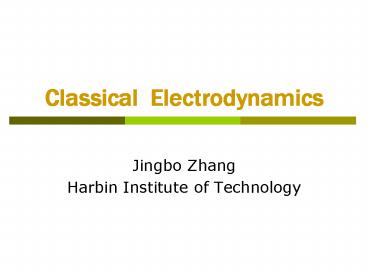Classical Electrodynamics - PowerPoint PPT Presentation
1 / 12
Title:
Classical Electrodynamics
Description:
Classical Electrodynamics Jingbo Zhang Harbin Institute of Technology Chapter 5 Special Theory of Relativity Review Lorentz s Transformation Question? – PowerPoint PPT presentation
Number of Views:1937
Avg rating:3.0/5.0
Title: Classical Electrodynamics
1
Classical Electrodynamics
- Jingbo Zhang
- Harbin Institute of Technology
2
Chapter 5Special Theory of Relativity
Section 6 Covariant Electrodynamics
3
Review
- Lorentzs Transformation
The Principle of Relativity Any
physical equation should be invariance under the
Lorentzs transformation.
4
Question?
- How about the electrodynamical equations?
- How to transform for electromagnetic fields and
potentials?
- Is Electrodynamics covariant in SR?
5
1. Electromagnetic Field
- Einsteins belief that Maxwells equations
describe electromagnetism in any inertial frame
was the key that led Einstein to the Lorentz
transformations. - Maxwells result that all electromagnetic waves
travel at the speed of light led Einstein to his
postulate that the speed of light is invariant in
all inertial frames. - Einstein was convinced that magnetic fields
appeared as electric fields when observed in
another inertial frame. That conclusion is the
key to electromagnetism and relativity.
6
But how can a magnetic field appear as an
electric field simply due to motion?
- Electric field lines (and hence the force field
for a positive test charge) due to positive
charge.
- Magnetic field lines circle a current but dont
affect a test charge unless its moving.
Wire with current
How can one become the other and still give the
right answer?
7
A Conducting Wire
0
Suppose that a positive test charge and negative
charges in a wire have the same velocity. And
positive charges in the wire are stationary. The
electric field due to charges in the wire will be
zero, so the force on the test charge will be
magnetic.
The magnetic field at the test charge will point
into the page, so the force on the test charge
will be up.
8
A Conducting Wire 2
0
Now transform to the frame of the previously
moving charges. Now its the positive charges in
the wire that are moving. And they will be
Lorentz-contracted, so their density will be
higher. There will still be a magnetic field, but
the test charge now has zero velocity, so its
force will be zero. The excess of positive
charges will yield an electric field.
The electric field will point radially outward,
and at the test charge it will point upward, so
the force on the test charge will be up. The two
cases can be shown to be identical.
9
2 The Four Current
Current 4-vector
Continuity equation
10
3 The Four Potential
Potential 4-vector
Lorentz Gauge
deLambert equation
11
Relativistic Transformations of E and B
12
Homework 5.6
- To derive the transformation of four-potential by
using Lorentz matrix.

